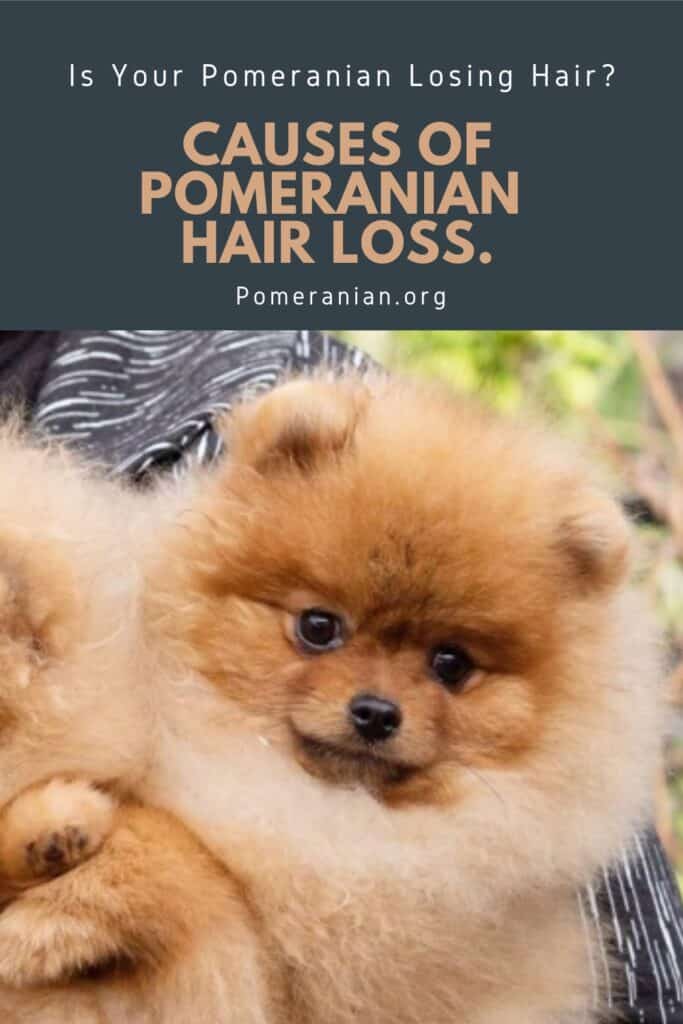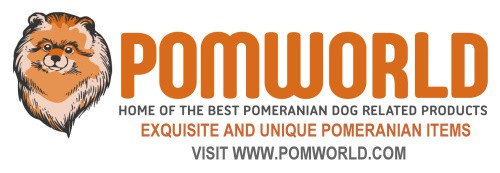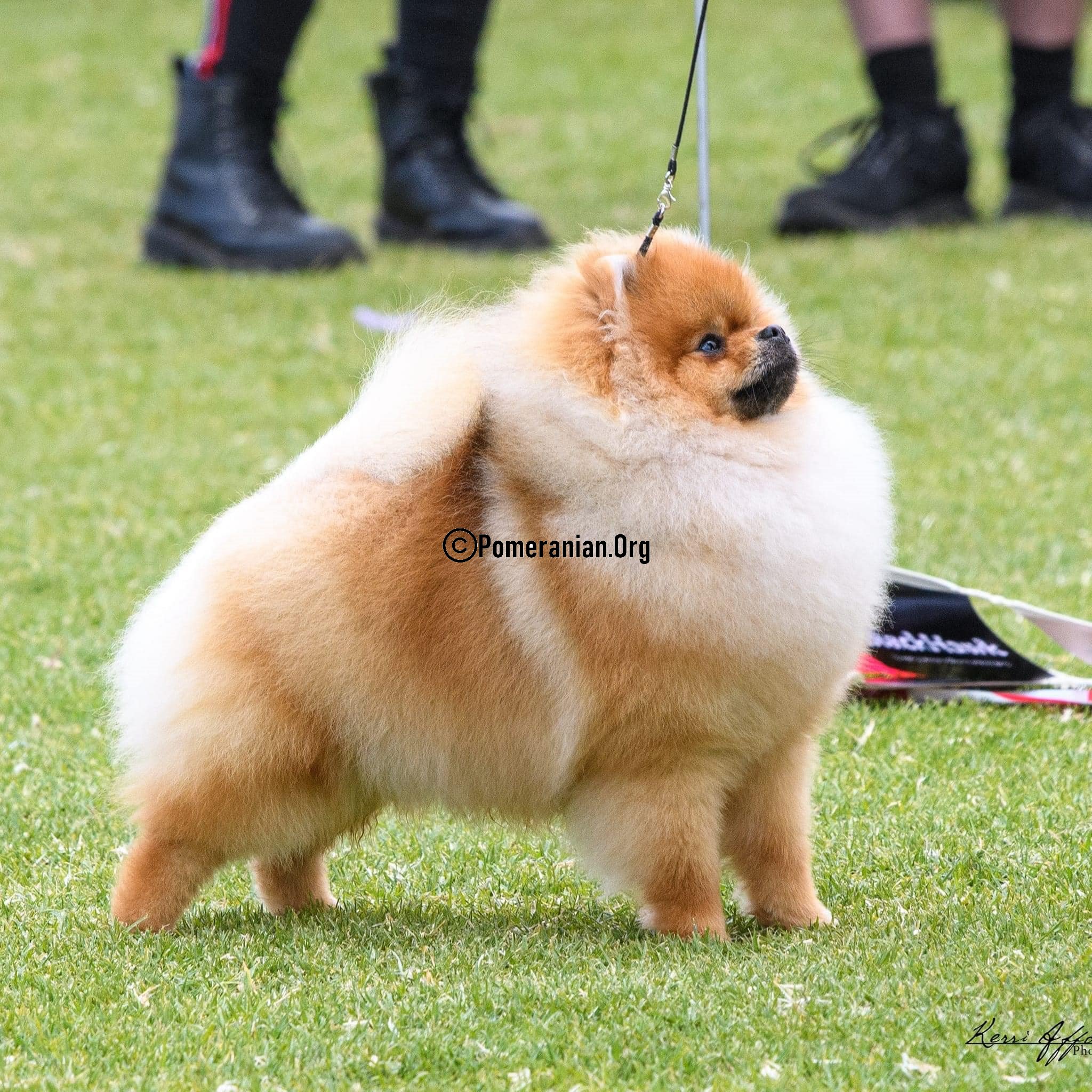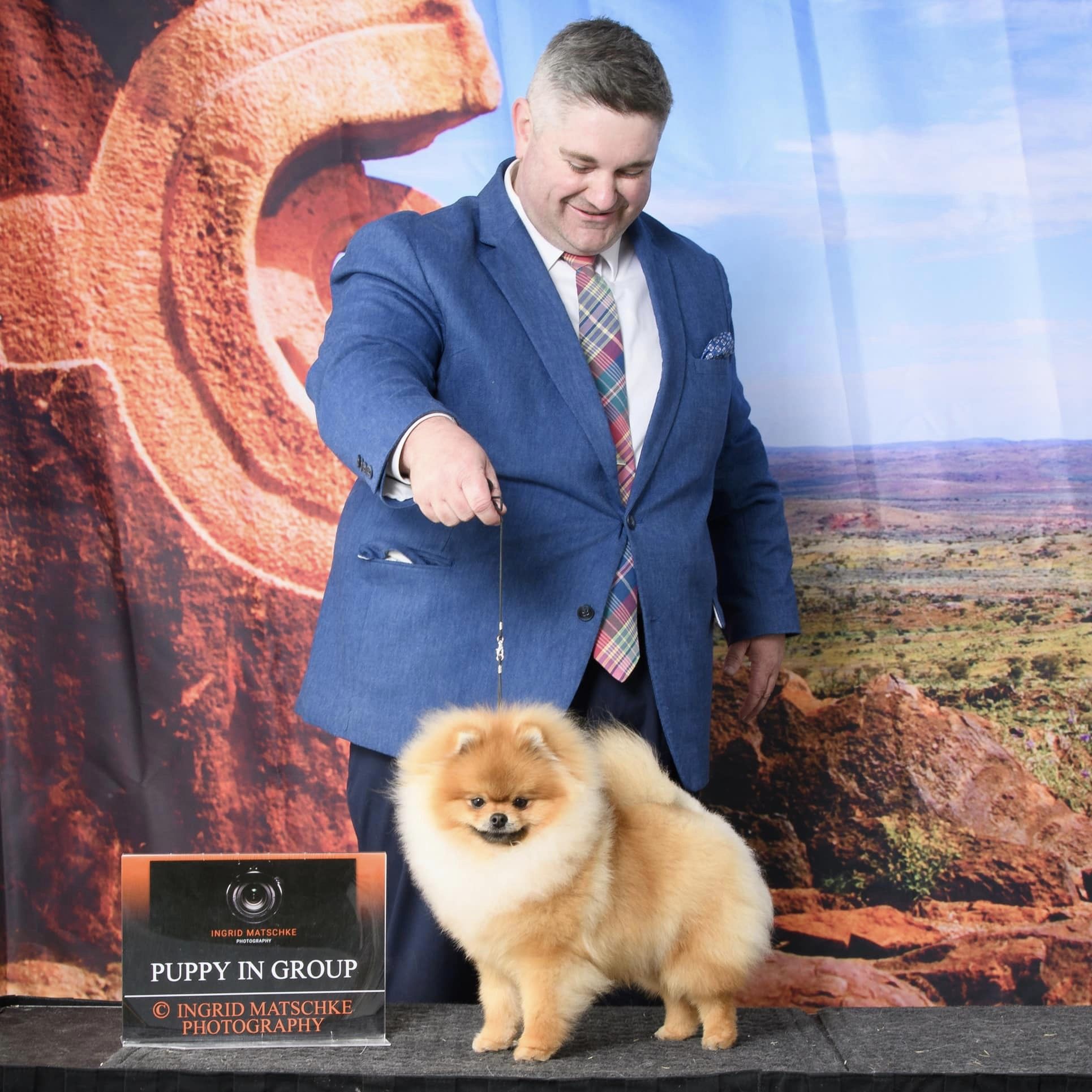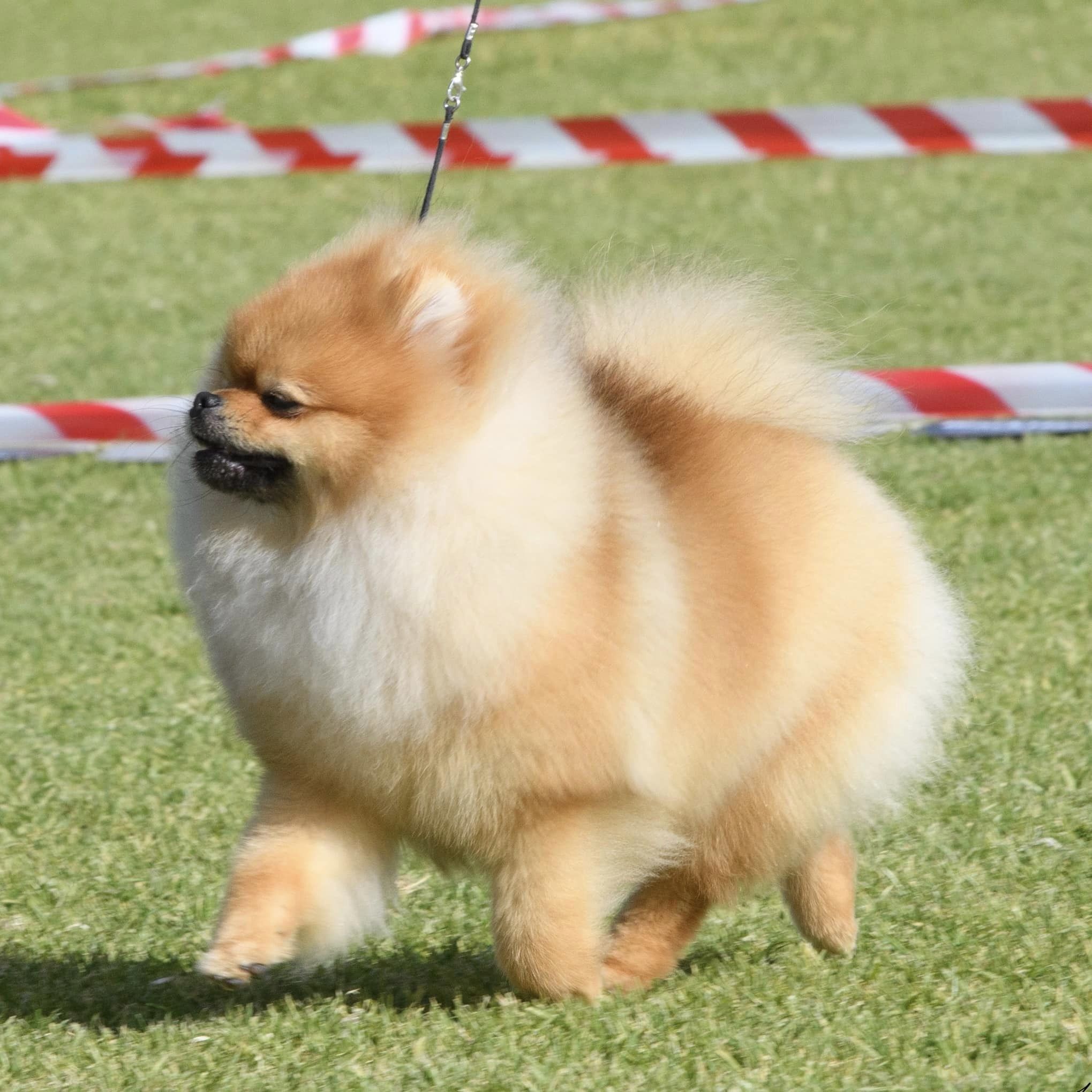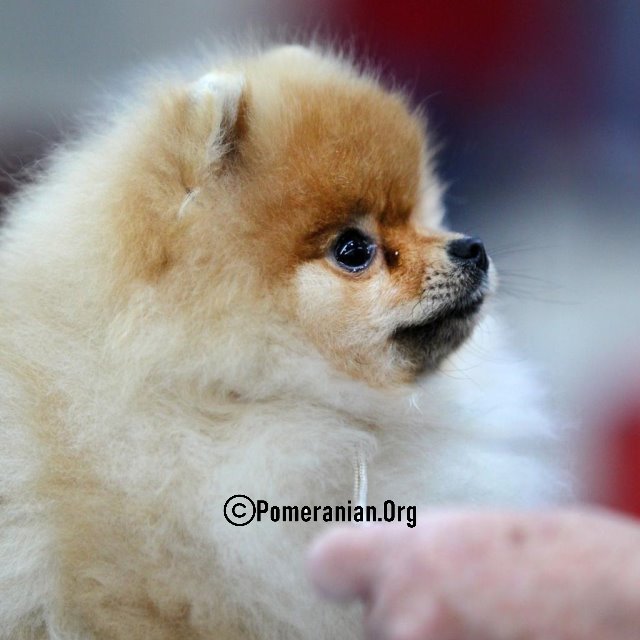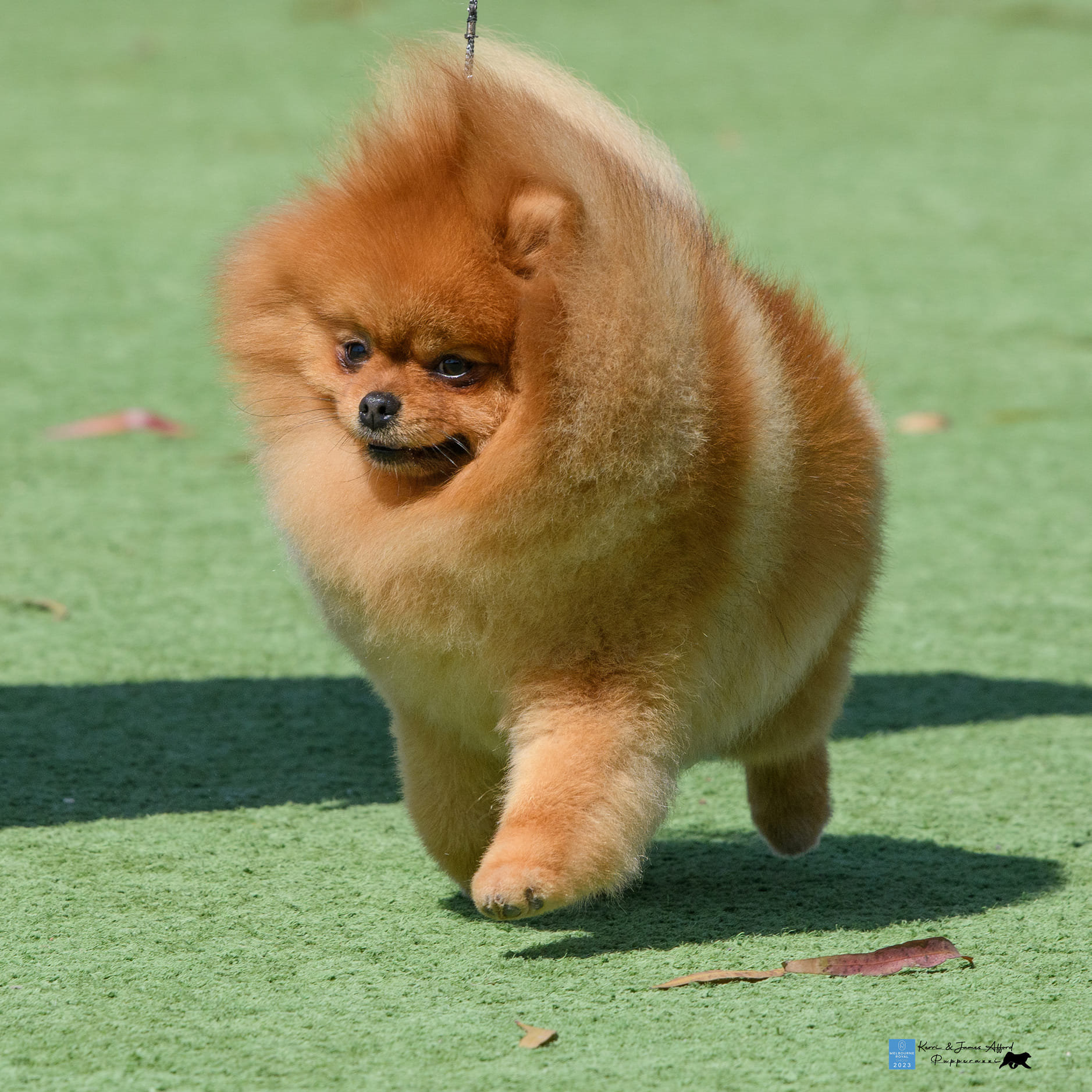Last Updated on 20/02/2024 by Denise Leo. Post first published on April 11, 2023.
Is your Pomeranian losing hair? Find out about hair loss in dogs, including its potential causes.
This article regarding Pomeranian health issues has been written in consultation with our resident Veterinary Doctor:
Dr. Muqeet Mushtaq
DVM, University of Animal and Veterinary Sciences, 2019
MSc. (Hons.) (Animal Breeding & Genetics), University of Agriculture Faisalabad, 2021
What Causes Pomeranian Hair Loss?
Pomeranians need proper care to keep their luxurious coat in full glory! The fur can become dry and brittle without regular bathing and drying sessions, leading to hair loss. Incorporating probiotics into your pet’s diet will also help nourish its locks for a beautiful long-haired look.
Create an appropriate self-care routine for your dog: it’ll be worth every minute!
Many medical issues and diseases can cause dog hair loss. Everything from allergies to hormonal imbalances could lead to your pup having a striking lack of fur!
Some reasons for Pomeranian hair loss may be regarded as “normal,” e.g., the puppy uglies and mothers dropping coat after whelping, whilst others may indicate that your Pomeranian has a serious disease.
Hair loss in Pomeranians can be problematic and frustrating, but rest assured that there are many underlying causes. It is best to start with getting a full work-up of your Pomeranian to rule out any serious medical conditions.
After that, ensure the dog’s diet is properly balanced and nutritionally complete to help maintain proper skin and healthy hair coats.
Finally, monitor your pup’s environment and lifestyle habits to ensure they are not subject to any stress or extreme weather conditions, which could also be a contributing factor.
By adequately understanding what causes Pomeranian hair loss, owners can start taking the necessary steps toward managing this condition and keeping their beloved pet in tip-top shape!
What Causes Pomeranian Hair Loss (Alopecia)and Treatments Available
Listed in the table below are the majority of ailments that cause dogs to lose hair, even a few that are rare. This comprehensive list enables you to appreciate why a vet may be unable to diagnose a problem quickly and he must perform numerous diagnostic tests.
The conditions underlined within this table are the most common reasons for hair loss in dogs. However, geographic locations may cause some of the results to vary.
| Condition | Description | Symptoms | Diagnosis | Treatment |
| Acanthosis Nigricans. | Dachshunds may inherit this form. Hormonal abnormalities, friction, or hyper-sensitivities usually cause a secondary form. | The skin color grows darker. (In its secondary form – see scratching and hair loss.) | Physical examination and history. In its secondary form, tests must be run to find the underlying cause. | Primary – no treatment. Secondary – treat the underlying disease. In many cases, vitamin E supplements and steroids may be used. |
| Acral lick dermatitis (neurodermatitis). | Dogs that lick themselves can cause self-trauma. Possible causes include boredom, anxiety, and stress (e.g., a new member in the home). Licking can become an obsession. | Red, hairless, raised lesions may appear on the dog’s legs. If it’s a chronic problem, it will drain. | Exclude other possible causes. History is essential. | Relieve the underlying cause – anxiety or stress. Use an Elizabethan collar to stop him from licking. The use of behavior-modifying medication could become necessary. |
| Adrenal sex hormone-responsive dermatosis. | Prevent the dog’s exposure to contact irritants or allergens within his normal environment. Antihistamines and steroids are used. | A microscope is used to examine the hairs and then do a biopsy. | A biopsy is done to rule out other potential causes. | Mitotane is one option. |
| Irritant and allergic contact dermatitis. | A dog may experience an allergic reaction after multiple exposures to any of the following: Antibiotics that are applied to the dog’s skin; Metals such as nickel; Rubber, plastic, and wool; chemicals including carpet deodorizers and dyes; inflammation due to poison ivy and other similar substances. | Blisters or bumps and red skin in parts of the dog’s skin with minimal hair. Direct exposure to any of the offending substances. Itching and hair loss in chronic cases. | Patch test, exclusion trials. | This problem is common in Samoyeds, Chows, Pomeranians, and Keeshonden. |
| Alopecia areata. | It’s believed to be a disorder of the immune system. | This often happens because of different problems, such as hormonal problems, parasites, or allergies. | Hair loss patches, particularly on the neck, body, and head, but no itchiness. | The recovery will be spontaneous. |
| Atopy (allergic inhalant dermatitis). | Hair loss, redness, itchiness, inflamed ears, and paw licking. The development of hot spots or infections may occur. | The dog can be allergic if he inhales house dust, pollen, mold, and mites. | Intradermal or blood tests to look for allergies. | It is caused by chronic pressure and is more prevalent in big dog breeds. |
| Bacterial infection (pyoderma). See Folliculitis. | Puppies are born with minimal or no hair. The small amount they have is gone by the time they’re four months old. | |||
| Black hair follicular dysplasia/alopecia/dystrophy. | Rare hereditary disease in dogs with hair of multiple colors; more common in Bearded Collies, Basset Hounds, Salukis, Beagles, Dachshunds, and Pointers | Loss of dark or black hair only; symptoms appear between 3 and 6 weeks of age; sometimes, scaling | Clinical signs, biopsy | Shampoos for scaling if necessary |
| Calluses. | It is most commonly done in dogs that aren’t neutered and is carried out on Keeshonden, Chows, Alaskan Malamutes, Pomeranians, Samoyeds, and Miniature Poodles. | Hairless, thick, raised spots above bony pressure points (e.g., the elbows). Secondary infections may occur. | History and clinical signs. | Give your dog better, softer bedding and padding around the problem area. |
| Castration-responsive dermatosis. | The coat resembles a “puppy coat.” Hair color may start to fade, and skin may become darker, resulting in severe scaling. The neck and genital regions have a symmetrical loss of hair. | Dogs with hair that continuously grows (e.g., Maltese and Poodles) can lose hair. Whiskers can be lost as well. | History and complete physical examination. Rule out other possible causes. Test blood to determine hormone levels. | Castration. |
| Chemotherapy. | Hair loss caused by chemotherapy is a big worry for owners of dogs with cancer. | No treatment. Once the dog has finished chemotherapy, his hair will grow back, but it may differ in texture and/or color. | History. | The mite is almost impossible, so a microscopic exam and skin scrapings are essential. |
| Cheyletiella (rabbit fur mite) mange. | Infected with the Cheyletiella mite. | Scaliness and itchiness. If it’s severe, hair loss may also happen. | No treatment. Once the dog has finished chemotherapy, his hair will grow back, but its texture and/or color may differ. | Pyrethrin and Permethrin (Do NOT use permethrin on cats.) |
| Color dilution/mutant alopecia. | It’s a hereditary problem in dogs with fawn or blue (diluted black) colored coats. It’s most commonly found in Great Danes, Whippets, Yorkshire Terriers, Dachshunds, Dobermans and Greyhounds. | At around six months of age, the hair on some dogs with fawn and blue-colored coats begins to thin out. Secondary folliculitis may also develop. | Breed, the color of the coat, and history. | No treatment. Avoid harsh shampoos and too much grooming. Protect the skin as much as possible to help Stop secondary bacterial infections. |
| Congenital hypotrichosis. | Congenital lack of hair. | CBC, chemistry panel, urinalysis, and tests for adrenal gland functionality. | Physical examination and then a biopsy. | None. |
| Cushing’s disease (hyperadrenocorticism). | Corticosteroids are the cause. It occurs if the amount in the dog’s body is increased naturally or due to prolonged use or high doses. | If caused by glandular tumors, remove the cancer through surgical means. If induced by the use of steroids, slow weaning off the steroids. | Skin thinning out, hair loss, easy bruising, hyper-pigmentation, comedones (blackheads), seborrhoea, lethargy, calcinosis cutis, a plump look, and urination and thirst. | The skin may darken in color and symmetrical loss of hair with defined borders, generally on the flanks and back. |
| Cyclic (cicatricle) alopecia; seasonal flank alopecia. | At some point in the year, the hair growth cycle stops. | Clinical signs, biopsy, and history. | Hair loss, scaliness, redness, boils, ulcers, sometimes itching, darkening of the skin | None. |
| Demodectic mange (red mange, puppy mange). | Infection with the Demodex mite – occurs when the immune system is deficient. | Loss of hair, scaling, redness, crusting, and muscles involved with chewing start atrophying and scarring on the tail, ears, and face. | Skin scraping and microscopic examination | No Steroids! Amitraz (Mitaban) dips. |
| Dermatomyositis. | Certain breeds are more likely to contract this condition. The causes aren’t known. It’s made worse by UV lighting and trauma. | Minimize exposure to UV lighting and trauma, fatty acids, vitamin E, and short-term prednisone usage. Some cases are too severe to respond to any treatment so that euthanasia may be considered. | Skin biopsy. | Thinning and hair loss, recurring bacterial infections, Seborrhoea, and infections. Unregulated dogs may have other diseases and conditions and may develop xanthoma or epidermal metabolic necrosis. |
| Diabetes mellitus (Type 2 diabetes). | Unusual immunity causes dogs with diabetes to be susceptible to infections and a myriad of other skin issues. | It varies widely, including redness, ulcers, hair loss, draining wounds, itchiness, and swelling papules. | Blood tests. | Insulin and changes to his diet. |
| Drug or injection reaction. | History of drug use, biopsy, and symptoms. | A rare skin reaction when a drug is given, topically or orally. It is more common with sulphonamides, penicillins, and cephalosporins and generally happens within the first fortnight of using the drug. | Red areas sometimes have ulcers, crusts, and loss of hair. The foot pads may become thickened. | Stop using the problem drug and treat symptoms as they appear. |
| Epidermal metabolic necrosis (necrolytic migratory erythema, hepatocutaneous disease). | “Bulls-eye” lesions, hair loss and blisters around the groin, mouth, ears and axilla. Fever may develop. Depression and ulcers may also develop. | It’s a rare skin disease that occurs in older dogs. Skin lesions may appear in dogs with specific diseases, including diabetes, liver disease, and certain pancreatic tumors. | Biopsy and ascertain the underlying disease. | Poor prognosis. Treat the identified underlying disease and offer support therapy. |
| Erythema multiform. | Crusts, scales, hair loss, redness, intense itchiness and bumps. Sometimes hotspots or infections may occur. | Clinical signs, skin biopsy, and history. Rule out diseases that can cause similar signs. | Overly sensitive reaction to drugs or infections. It may be caused by cancer or numerous other diseases. | Remove or treat the underlying cause. |
| Estrogen-responsive dermatosis (ovarian imbalance type II). | It is more typical in boxers, dachshunds, and young dogs that have been spayed. | Hair loss originates in the flanks and genital region and moves forward. The coat resembles a puppy, and the hair color could fade. | History and a physical examination. Rule out other options—response to therapy. | Estrogen replacement therapy. WARNING – can have severe side effects. |
| Flea allergy dermatitis (flea bite hypersensitivity). | Severe reaction to a flea’s saliva. | Hair loss, sometimes only a specific color and scaling may also appear. | Reaction to intradermal testing and fleas are present. | Use flea control methods in the environment and on the dog himself: antihistamines and steroidal use to ease the itchiness. |
| Follicular dystrophy/alopecia/ dysplasia (abnormal development or growth of hair). See Congenital hypotrichosis, Colour dilution/mutant alopecia, black hair follicular dystrophy/alopecia, and Follicular dysplasia (non-color linked). | Hair loss in patches experienced by dog breeds such as the boxer, Siberian Husky, Airedale, Doberman Pinscher, Portuguese Water Dog, Irish Water Spaniel, Bull Terrier, Staffordshire Bull Terrier, Boxer, and Curly Coated Retriever. | Breed, clinical signs, and skin biopsy. | It’s congenital in certain dog breeds, which increases the risk. It may be acquired when a dog is much older from cancer drugs, hormonal imbalances, infections, and other diseases. | If it’s an acquired disease, treat the underlying reason. If it’s congenital, treat secondary issues, including scaling or infections. |
| Follicular dystrophy/dysplasia (non-color linked). | In Dobermans, hair loss is over the dog’s lumbar area. The Huskies have a reddish color to their hair, and some hair is lost. In Terriers and Boxers, the skin could be hyper-pigmented and the lumbar area will lose hair. Spaniels and Retrievers lose guard hair on their trunks and backs. The secondary hairs are lighter and duller in color. | Pustules in the follicles break open to create annular, target, and bull’s-eye lesions with crusty centers. There may be a darkening or red effect on the dog’s periphery and epidermal “collarettes” that look like scaly skin rings. It may cause itchiness. Breeds with short coats can develop tufts of hair which then fall out. Breeds with longer coats may contract seborrhoea. | Breed and biopsy. | None. |
| Folliculitis. | Hair follicles may become infected, sometimes with staph bacteria. Symptoms generally appear on the dog’s body in places with minimal hair –e.g., the abdomen. | Cultures, scraping of the skin, and biopsies. | Antibiotics for a month minimum. Give your dog the drugs for at least ten days after it seems cured. If it returns, try to determine the underlying cause. It may be a hormonal imbalance or an allergy. | Inflamed ears, licking paws, redness, itchiness, and loss of hair. Hot spots or infections may develop. |
| Food allergies. | He is allergic to something in his food. | Clinical signs, history, biopsies, and possibly exploratory surgery. | Try different foods and watch for his reactions so you can eliminate certain foods and hopefully discover the allergens. | Change the dog’s diet. |
| Granulomas. | It isn’t well understood and is believed to be due to an enzyme deficiency. The second option is a decrease in adrenal hormones, allowing certain other hormones to amass in the body. Common in: Poodles, Samoyeds, Chow Chows, Keeshonden and Pomeranians. | Varied sizes of firm, solid nodules. If the cause is foreign bodies, they’ll sometimes have draining tracts. Your dog may get ulcers, lose hair, or have secondary infections. | Infections are one cause. The dog’s reaction to foreign matter such as plant materials, sutures, material, other regular irritants, or unknown reasons. | Surgical procedure to remove whatever foreign body is in your pet’s body. If it’s plant material, there may be extensive tracts that could require major surgery. If it’s an infection, use antibiotics. Also, treat other underlying causes. |
| Growth hormone-responsive alopecia. | Generally appears when a dog is under two years old—hair loss on the tail, neck, and back of the thighs. The skin turns a darker color. | Hormone supplements, growth hormones, or neutering the animal. | Hormonal blood testing. | Hair loss and nodules are caused in all cases. Systemic and malignant forms have ulcers, too. |
| Hair loss during pregnancy and nursing (‘blowing her coat,’ telogen effluvium). | Excessive shedding may also happen during other stressful times, including surgery or sickness. | Widespread, sudden loss of hair. | Clinical signs and history. | Hair will eventually return. Treat underlying causes. |
| Histiocytosis. | Several types. Malignant: cancer that affects the dog’s internal organs and skin. Systemic: a rare disease affecting internal organs and skin. Cutaneous: Benign disease that affects the skin. | Rare disease. Female dogs have too much estrogen. It may be due to ovarian cancer. | Fine needle aspiration or biopsy. | Malignant: nothing effective. Might need to think about euthanasia. Systemic: responds poorly to chemotherapy drugs. Cutaneous: corticosteroids. It’s common to have a relapse, particularly in, Shar-Peis. |
| Hyperestrogenism (ovarian imbalance type I). | Symmetrical hair loss and can be pulled out easily. Skin darkens in color. Enlarged vulva and nipples. In rare cases, there is also itchiness and seborrhoea. | CBC, chemistry panel, and test the function of the thyroid gland. | Physical assessment and history. Eliminate other hail loss causes. Measure the levels of estrogen in the blood. | Spay the dog. Look to see if the lungs have metastasized. |
| Hypothyroidism. | Reduced thyroid hormone production. The number one hormonal disease that affects dogs’ skin. | Loss of hair. Brittle, dry hair. Seborrhoea. Secondary yeast and bacterial infections. Lethargy, slow heartbeat, obesity, skin pigment might change. | See seborrhoea if there are any changes to the skin. Hair loss on the trunk. Perianal glands and the tail gland become enlarged. Skin pigment may increase. | Must be given thyroid supplements for the rest of his life. |
| Injection site alopecia. | Hair loss at an injection site where a vaccine or medication has been used. Skin can thicken. Cats may develop ulcers. | Hair loss happens a few months after such an injection. That area may also become hyper-pigmented. | Physical exam and history. | Nothing. This is a permanent problem. |
| Interstitial cell tumor. | Tumour on the testicle. Might not change skin color. | Loss of hair, nodules, and numerous draining tracts. Other ringworm indicators may be invisible to the naked eye. | Biopsy. | Anti-seborrheic shampoos or castration. |
| Kerion. | A complication of a ringworm infection. | Clip the affected area and use shampoo and topical treatment. Possibly need systemic therapy with ketoconazole. | Culture and a biopsy. | The cause is a parasite of blood cells. It might be transmitted to humans, who then succumb to a severe form of the disease. |
| Leishmaniasis. | Loss of hair, ulcers on the ears and nose, and scaling. Sometimes nodules appear as well as other signs unrelated to the skin. | Hair loss, itchiness, rough coat hair, and crusts. | Blood tests. Identify the problem organism in either the blood or via a biopsy. | Because people get a severe form of the disease and dogs can’t be cured, euthanasia is usually the best choice. |
| Lice. | Several types of lice cause an infection. | Usually, it follows a different underlying disease. | Discovering nits or lice on the skin or in the hair. | Pyrethrin, ivermectin (off-label use*), Permethrin. (DON’T use permethrin on cats.) |
| Malassezia. | Greasy scales, hair loss, redness, and itchiness. If it’s chronic, hyper-pigmentation may occur. | Skin scraping, smears, microscopic exams, and cultures. | Three types. Loss of hair may happen on Dachshund’s ears. It may occur on the tails, thighs and necks of Portuguese Water Dogs and American Water Spaniels. The back of the thighs and abdomen of Greyhounds, Chihuahuas, Dachshunds and Whippets. | The underlying disease has to be treated. Miconazole shampoos or oral ketoconazole. |
| Nasal solar dermatitis See solar dermatitis. | See solar dermatitis | |||
| Pattern alopecia (pattern baldness). | History, breed, and biopsy. | Lost hair in the described areas. | Affect parts of the skin that touch the ground: redness, intense itching, scales, crusts, hair loss and papules. | Nothing. |
| Pelodera dermatitis. | Caused by non-parasitic worms living in straw and other types of organic materials. The larvae cause the problem accidentally. | It is a hereditary problem where the pituitary gland can’t make the necessary hormones. | Microscopic exam and scraping of the skin. | Remove the bedding. Use a mild antibacterial shampoo. If necessary, ease the itching with steroids. |
| Pituitary dwarfism. | Young puppies don’t grow. Dogs keep their puppy coat. This condition causes hair loss on most of the body as well as scales, thin skin, and secondary infections. | Hair might not grow back as soon as it has been clipped. The animals it can affect can’t be predicted but it’s more common in dogs with thick undercoats, such as Chows and Huskies. | Special blood tests to detect specific hormones. | Hormone replacement therapy. |
| Post-clipping alopecia. | Ongoing lack of new hair growth after being clipped (e.g., for surgical procedures.) | It begins as hairless red areas, and soon after that, it becomes draining ulcers, which can get infected. | History. | None. However, hair generally grows back but can take up to two years. |
| Pressure sores (decubital ulcers). | Self-trauma and intense itching. Loss of hair, scales, crusts, and bumps. | Lesions appear on bony areas such as the elbows. It is more common in bigger recumbent dogs. | Clinical signs and a biopsy. | Keep the affected area(s) clean and prevent urine contact. Antibiotics and donut bandages for padding around the area but not directly over the ulcer. Prevent ulcers by turning your dog every two hours. Surgery may be indicated. |
| Pyoderma-superficial. | ||||
| Ringworm. | Infection is caused by several fungi types. | Crusty areas, scaliness, hair loss, vesicles, itchiness and pustules. A Kerion (draining nodule) may develop. | Culture. | Miconazole and lime sulfur dips. Oral griseofulvin or Iitraconazole. |
| Sarcoptic mange. | Infected with the Sarcoptes mite. | Breed, clinical signs, and a skin biopsy. | Mite is very hard to find. Scrape skin and microscopic exam. | Amitraz (Mitaban) dips. (off-label use.*) Ivermectin. (off-label use.*) |
| Schnauzer comedo syndrome. | Rare and only in Miniature Schnauzers. | It can be primary (genes) or secondary causes. The latter occurs as a result of other diseases, allergies or hypothyroidism. | Comedones (blackheads) on the back and some mild itching. Possible secondary infection, small crusts, and thinning of the hair. | Long-term use of anti-seborrheic shampoos. Retinoids and antibiotics may be used. |
| Sebaceous adenitis. | An unknown cause destroys the sebaceous glands. Some breeds are more susceptible than others. | Breeds with short hair: Hair loss in circular areas with a fine scale. Breeds with long hair: Hair loss is more widely spread, and scales appear. Itchiness can occur in all breeds. | Breed, clinical signs, and a skin biopsy. | Fatty acid supplementation and antiseborrheic shampoos. Retinoids and steroids for the more severe cases. |
| Seborrhoea. | Hail loss, redness, and scaling on the ears and nose. Later ulcers and crusts can form. | Scales. Some breeds may have an oily or dry coat. Odor and hair loss may be a result of scratching. | Scrape the skin and do blood tests to determine the underlying reason. | Treat underlying cause if it’s discovered. Fatty acid supplementation and use of antiseborrheic shampoos. |
| Sertoli cell tumor. | Middle-aged dogs can get testicular tumors. | Male dogs can take on the sexual characteristics of female dogs. Increased hair loss, red area on the prepuce. | Physical examination. | Castration. |
| Solar dermatosis. | Skin reacts to sunshine, especially if it’s unpigmented. Most commonly appears on the nose of Shelties, Collies, and other similar dog breeds. | Breed, history, physical examination, and a skin biopsy. | The docking site has a nodule that itches and causes self-mutilation, hyper-pigmentation, and hair loss. | Avoid more exposure to sunshine, particularly between 9 am – 3 pm. Use sunblock or steroids. Apply black ink or tattoo the nose. |
| Tail dock neuroma. | Nerve regrows after symptoms caused by tail docking. | At the top of the tail near the base is a sebaceous gland. That gland becomes bigger. It is common in unneutered dogs and is secondary to other issues, including hypothyroidism. | History and symptoms | Surgical removal. |
| Tail gland hyperplasia. | It might not be caused by low vitamin A levels but can respond if the amount used is increased. Most commonly found in Cocker Spaniels. | Dry coat, scaly, dull, Seborrhoea, loss of hair in the anal and genital regions, and progresses onto the dog’s trunk. | Clinical signs; and search for the underlying cause. | Hair loss, crusts, oiliness, and hyperpigmentation occur over the gland. |
| Testosterone responsive dermatosis (hypo-androgenism). | Most commonly found in Afghans and neutered older dogs. | Treat the underlying cause. Castration may be a good idea, and surgery may be required to remove it. | History and physical exam. Rule out other causes—response to therapy. | Testosterone replacement therapy. |
| Vitamin A responsive dermatosis. | Seborrhoea, smell, hair easily pulled out, thick foot pads & thick scales on abdomen and chest, particularly around the nipple area. | Breed, clinical signs, and biopsy of the skin. | Three types: 1. Malamutes and Huskies. 2. In fast-growing puppies in big breeds. 3. In English, Bull Terriers. | Permanent vitamin A treatment. |
| Zinc responsive dermatosis. | Breed, history, physical examination, and a skin biopsy. | Loss of hair, scaliness, redness, crustiness, and oily skin (sometimes). Secondary bacterial infections are common to all three types. | Fix dietary deficiencies, use medicated shampoos, and treat secondary infections. | Fix dietary deficiencies, use medicated shampoos and treat secondary infections. |
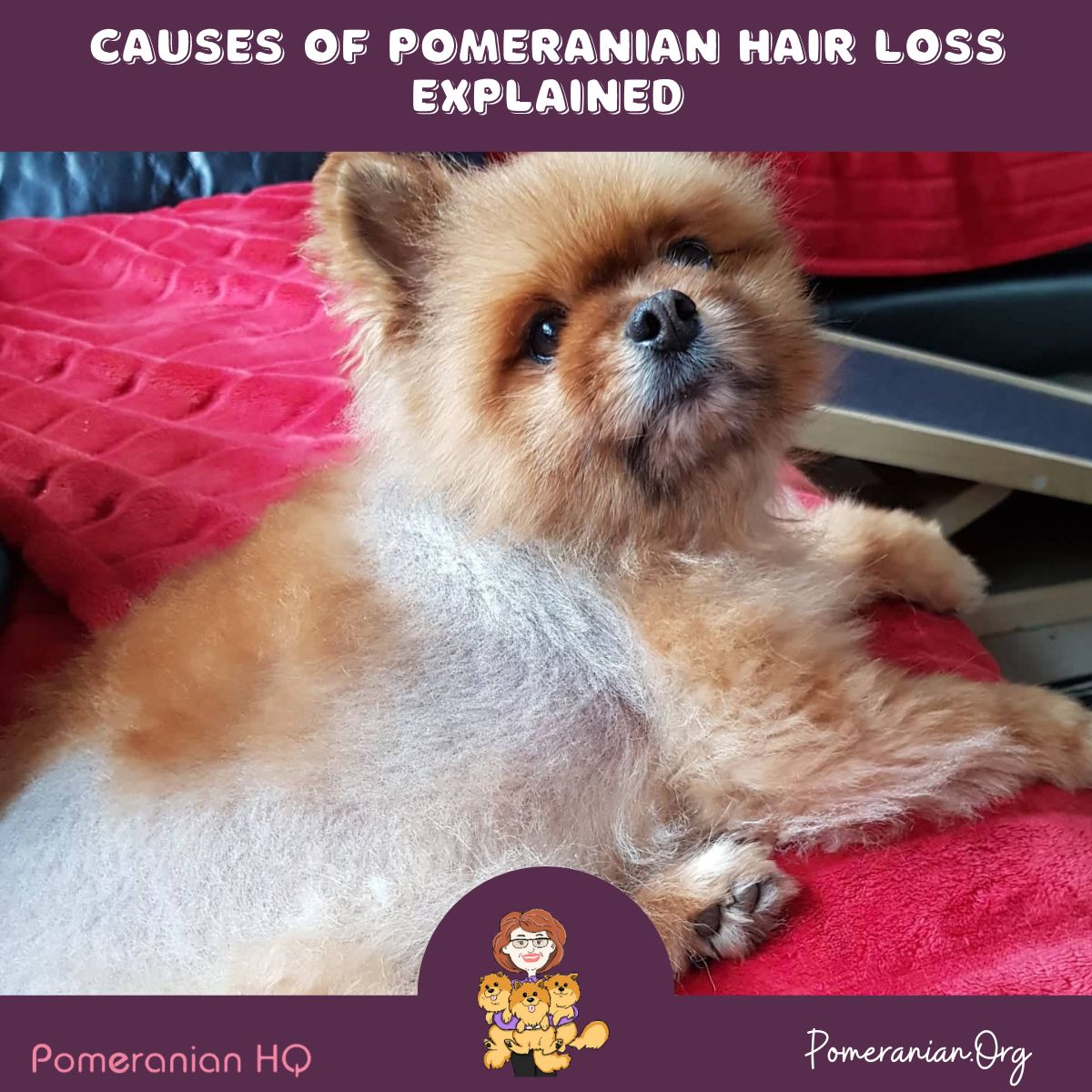
Causes of Pomeranian Hair Loss Conclusion
Hair loss in Pomeranian dogs can be an alarming experience for any pet owner, but armed with the knowledge of why their fur might be off, it’s essential to ensure that you make the best decision for your pup.
With proper nutrition, environment, maintenance, and a trip to the vet for treatments or advice, you can address the possible causes of hair loss and get your Pomeranian back to its happy and huggable self.
Don’t let unexpected stressors cause distress for both you and your pup. Make sure to keep an eye on their health so that you can take proactive steps to help them reach their optimal level of well-being.
Disclaimer: The Content is not a substitute for professional veterinarian advice, diagnosis, or treatment. Always seek the advice of your veterinarian with any questions you may have regarding your dog’s medical condition. Never disregard professional advice or delay seeking it because of something you have read on ANY website.
Copyright Pomeranian.Org. All Rights Reserved.
References: Denise Leo, The Pomeranian Handbook.
The Pomeranian Handbook
